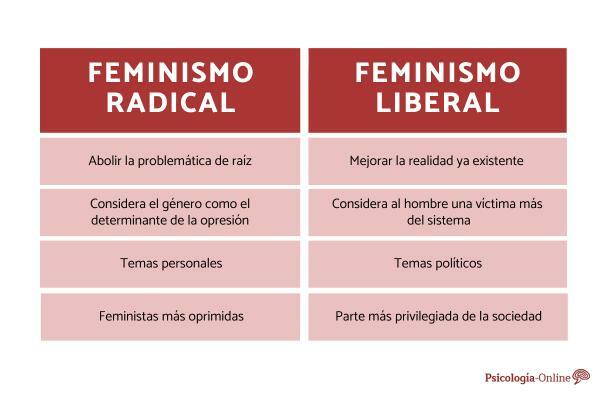
Feminism was born at the end of the seventeenth century, as a social and political movement. Since always, there have been women who have claimed and fought to improve their rights and their position within society, so that the history of feminism goes back decades. Its historical beginning took place after the French Revolution, at which point it was considered the first wave of feminism in the fight for rights and legal equality. The first organized movements were born in the second wave of feminism, which took place until the 1960s, with the first suffragettes. Later, the third wave called "contemporary feminism" appeared in which we find ourselves today.
Throughout this historical trajectory, various feminist currents have stood out, in which we find liberal feminism and radical feminism. In this Psychology-Online article, we will see what liberal feminism is and what radical feminism is and we will make a historical and conceptual review of the differences between radical and liberal feminism.
Contemporary feminism is born in the third wave of feminism, arising as a result of the revolutions of the 60s. This movement understands society as a system made up of social classes and sexes, which drives the movement to liberate the role of women. In the third wave or contemporary feminism, many aspects of feminism are born, highlighting among others, liberal feminism and radical feminism. However, there are many other types of feminism nowadays, like transfeminism or intersectional feminism.
In this article you can see the history of the feminist movement through the four waves of feminism.
Liberal feminism was promoted in 1966 by Betty Friedan, who has been considered the highest representative of this movement in the National Organization for Women (NOW). Liberal feminism does not focus its attention on the possible oppression or exploitation of women, but on situating the position of women as a situation of inequality. Against this, the objective of liberal feminism is to achieve a reform of the system to obtain equality between both genders.
One of the main objectives to achieve equality in the system was to guarantee the inclusion of women in the labor market and they sought to promote a change in the political sphere, allowing women to hold political office. However, the emergence of radical feminism captured the attention of the youngest, gaining much prominence in the 1960s and 1970s.
The radical feminism begins to gain weight in the sixties. It was born from the idea that although there is a legitimation of rights, the system continues to be governed by sexist, class, racist and imperialist values. This reality motivated the creation of the New Left and radical social movements, among others radical feminism.
The main characteristic of radical feminism is based on its countercultural character, on which they did not seek a reformist policy, as in the case of liberal feminism, but on forge new forms of society.
The first decision of this movement was to establish an autonomous women's organization, establishing a separation with the male gender. Although all people who followed radical feminism agreed on the need to disassociate themselves with men, they were in opposition in relation to the nature and the end of the separation. Faced with this, the radical feminism first division, on which two subgroups were forged: feminists in "politics" and "feminists". However, despite its theoretical and practical differences from the different developed subgroups of the movement, it maintains common approaches.
- Policies. They highlight the idea that the oppression that women have suffered is due to capitalism or the system. In this aspect, feminism was considered one more part of the left.
- Feminists. They were against subordination to the left, because they classified men as the main beneficiaries of its domination. This position defends that the oppression of women is not based solely on the system, but that they understood that the system of which they were part was a specific system of domination by men, which defined women in terms of male. On the contrary, the policies conceived of man as another victim of the system.
The main objection of radical feminism is based on patriarchy, described as a sexual denomination system that oppresses women and on this basic scheme, other dominations such as class and race are born. The most representative of his movement was the slogan: "the personal is political", indicating that domination patriarchal was also practiced in areas of personal life, such as in the family structure and in the sexuality. This group highlights that men, and not just a group of them, receive sexual, economic and, above all, psychological gains from the patriarchal system.
Notable in the radical movement, the organization of self-awareness groups. In them the aim was to raise awareness among all women on the oppression of women in society, from their own experiences and not from ideological constructs. This group was also the driving force to revalue our way of speaking.
On the other hand, it is worth highlighting the activism of this group, which organized massive demonstrations, as well as acts of protest and sabotage to demonstrate the position of women in the patriarchy, carrying out actions such as the public burning of bras, thereby making the voice of the movement resound throughout the society. In addition to this set of protest acts, were the establishment of alternative aid and self-help centers, health centers, day-care centers, self-defense centers,… Demanding in self-awareness groups a fundamental characteristic in them, equality and anti-hierarchy: neither woman could position herself above the other. Because of this premise, many leaders were expelled from the movement and it was the diversity of opinions within the group towards the lack of structure of the movement, which led to the decline. Finally, the wear of the movement due to its characteristics, contributed to the completion of the movement in the mid-seventies.
Along the the history of feminism, various feminist currents have emerged, two of which are liberal feminism and radical feminism. What do radical and liberal feminism have in common? How do radfem and libfem differ?
Once the two manifestations of feminism have been exposed and their differences observed, let's briefly summarize the four main differences between liberal feminism and radical feminism:
- The objective radical feminism lies in abolishing the root problem, eliminating prostitution, pornography and in general, the construction of the social system. Also capitalism because it is considered the basis of oppression. In contrast, liberal feminism seeks to modify and improve the existing reality.
- The conception of man. Another difference between radical and liberal feminism is that liberal feminism does not observe gender as the determinant of oppression, since it considers man another victim of the system. However, in radical feminism, they understood that the system of which they were part was a specific system of domination by men, which defined women in terms of men.
- The conception of politics. Liberal feminism deals with issues with a more political determination, such as the position of women in the world of work. On the contrary, radical feminism observes that in the face of the new legislation, the oppression of women continues to be notorious in aggressions, rapes, relationships, etc. Here you can see the different types of gender violence. For this reason, he establishes the motto "the political is personal" and begins to deal with issues of a more personal nature.
- Social position. Another difference between radical and liberal feminism is the position and vision of society. The activists of the liberal group were part of a more privileged part of society, which had the possibility of accessing audiences, forums, power and money. In contrast, the radical feminist position was one of double or triple oppression.

This article is merely informative, in Psychology-Online we do not have the power to make a diagnosis or recommend a treatment. We invite you to go to a psychologist to treat your particular case.


